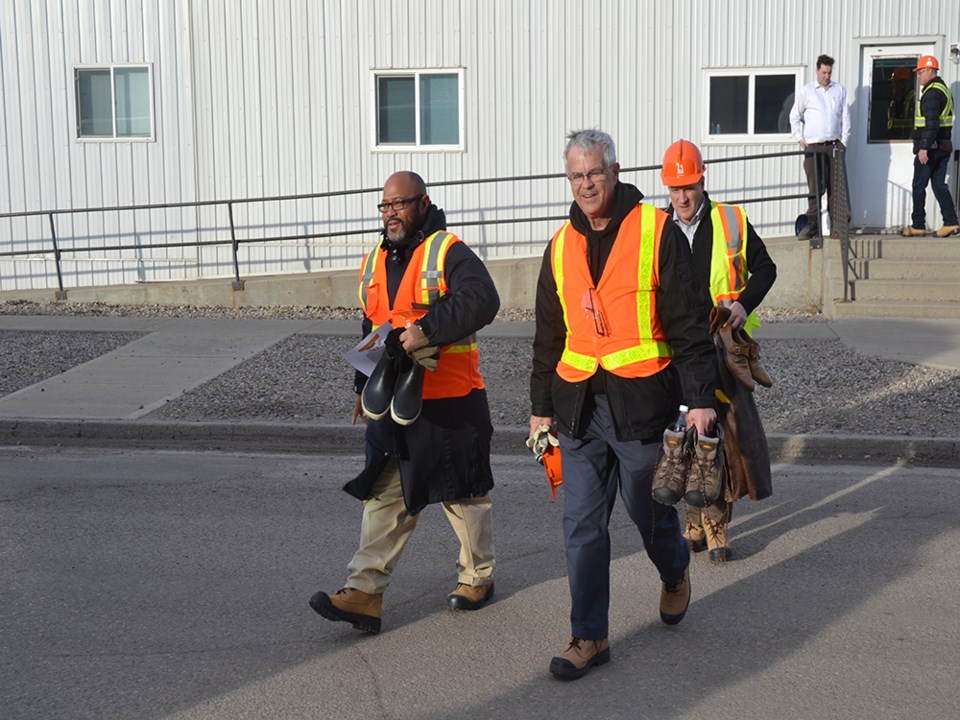SaskPower is optimistic about the progress made with maintenance on its carbon capture and storage (CCS) project. Hosting a tour on Dec. 7, representatives of the company announced that it has a new goal of capturing 800,000 tonnes of CO2 in 2016.
A blog entry on SaskPower’s website said the capture process was back online on Nov. 2 and capturing CO2 by Nov. 6. During a period of time between Nov. 14 and 16, Unit 3 ran at maximum process capacity, capturing approximately 3,420 tonnes of CO2 produced in that time, at Boundary Dam.
The company shut down Unit 3 for regular maintenance in a four-week outage. Maintenance included replacing a large containment vessel that held the main chemical solution used in the carbon capture process; mechanical fixes on numerous system components and the cleaning and relocation of certain parts of the system.
The Crown corporation gave a tour of the power station and Unit 3 for dignitaries who were part of the Midwest Legislative Conference, a group consisting of representatives from the U.S. and provinces of Alberta, Saskatchewan, Manitoba and Ontario.
Wayne Elhard, a co-chair of the Midwest-Canada Relationship Committee said that despite it not performing as expected, the carbon capture technology at Boundary Dam Unit 3 could be commercialized and sold around the world, and that the technology was well on the way to being fully functional.
“There’s no hard dollar figure attached to this concept yet. I think we’re going to want to see how effectively it works in the long term, before we can attach that kind of value to the technology,” said Elhard after completing a tour of the facility.
Elhard noted how important it was not to make hasty, mindless decisions, with deadlines approaching for the CO2 emission restrictions in the US. He emphasized the importance of the Midwest-Canada Relationship Committee making qualified decisions about how reliable and applicable to the Midwest states the technology is.
Elhard said, “We’re selling a concept and an idea that we think is workable, and has application in coal plants around the world.”
Interested in doing just that, André Thapedi, a state representative from Illinois, a chairman of the International Trade and a Commerce committee, vice-chairman of public utilities and energy committee in the House of Representatives, was among the guests present for a tour of the facility.
Thapedi said that while things are still very early in the process, he found the progress made, and the technology present at Boundary Dam to be interesting.
“This looks to be an innovative approach to dealing with the carbon issues. I don’t think it’s confined to Illinois (or) confined to Saskatchewan. It’s something that has to be addressed, and addressed rapidly,” said Thapedi. “At the end of the day we have to reduce carbon emissions in the atmosphere, however we can get it done. I appreciate the Saskatchewan government giving us this opportunity, and the people of SaskPower giving us the opportunity to learn more on this fact-finding mission.”
Thapedi’s interest in the carbon capture project was due to the fact that the United States Environmental Protection Agency (EPA) has ordered states to create implementation plans for emissions that comply with the Clean Air Act — a law that requires Illinois and other states to look at ways to decrease their CO2 emissions.
“I’m here to do a full-blown study, to see what information I can garner and what information I can take back to my state. How we can meet the president’s guidelines and get it done as quickly as possible,” said Thapedi. “It’s early in the process, and it’s not just a matter of looking out for the environment, but also coming up with means to produce revenue that would offset some of the costs.”
In response to what he’d seen and learned, Thapedi noted he would “take it all in,” and think it over.
Opposition environment critic Cathy Sproule was among the dignitaries present for the tour, in what was her first visit to Unit 3. Sproule spent the day asking a great deal of questions, and contended that there needs to be more transparency, and that there wasn’t enough so far, in SaskPower’s account of how well the technology had done.
“We were told it was operating and fully functional and we had to find out through other means that it wasn’t what was going on,” said Sproule. “It’s important the information being provided is accurate.”
When asked if she advocated shutting down the carbon capture process, Sproule said the shutdown that lasted from September until November is not a valid option, with $1.5 billion in taxpayers’ dollars already invested into the project. She noted it’s important the technology works at this stage.
“What I’m hearing is that SaskPower is selling an idea. This technology is not a sold deal even for SaskPower, because they’re still planning what they’re going to do with Units 4 and 5,” Sproule said during an interview after the tour. “They’re still ramping up, and from what we hear, it’s going to be another year before SaskPower can even decide, and we know.”
At the end of the event, Howard Matthews, vice-president of power production with SaskPower, reported the facility has been running well, with progress being made since the shutdown. Matthews said that in November, Unit 3 captured 60,000 tonnes of C02.
“We have a much better understanding of what the cost of operations are,” said Matthews, describing the rationale behind the new, lower target of 800,000 tonnes of CO2 for 2016. “It’s a new facility, the first of its kind in the world. We’re working to run the facility reliably and cost-effectively.”
Matthews said given the scope and magnitude of the carbon capture facility, and the fact that it’s the first of its kind in the world, it takes time to get the technology running optimally at
full capacity.




